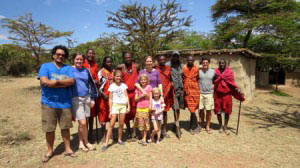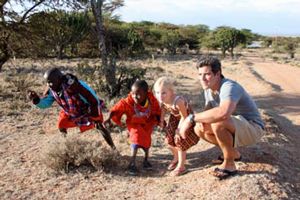Excerpt from the Demers Family Blog
“We had the MOST SPECTACULAR experience at Maji Moto Maasai Cultural Camp with our three girls. It was an experience we will never forget and will be a highlight of our big globe crossing trip. The staff was incredible, the experience fascinating and authentic, and the kids dove into it all and wanted to stay for a month! I can’t tell you how impressed we were with everything, particularly Salaton and Helen. Thank you for all you did to arrange it all!” ~ Blair, Portsmouth, New Hampshire
“Sopa!” (traditional greeting in the Maasai language) This may be one of the most difficult posts to write, because our two days at this Maasai cultural camp were so incredible it is hard to put it all into words.
Maji Moto Cultural Camp, located near the town of Narok in Kenya’s Great Rift Valley, is an authentic and meaningful example of “cultural tourism” that we first learned about from a small article in an August issue of the New York Times. Run by a Maasai warrior Chief named Salaton Ole Ntutu, the camp offers visitors a unique and intimate window into the world of the Maasai people. We spent our days walking the hills with Maasai warriors, learning about village life, making beaded jewelry with Maasai women, visiting a local primary school for vulnerable Maasai children, and practicing our skills during “warrior training” (major highlight). Our nights were spent singing Maasai songs around the campfire, hearing the warriors’ stories about wrestling leopards and lions to protect their cows, bathing in the nearby hot springs (“Maji Moto” literally translates as “hot water”), and sleeping in traditional mud huts or “manyattas” (with a few Western perks such as beds with mosquito nets and mattresses made from something other than the cowhide strips that the local Maasai sleep on). Here is the website for anyone who is interested in learning more: www.majimotomaasaicamp.com
Our journey to Maji Moto was a bumpy, 4-hour adventure, with a breathtaking drop down into the Great Rift Valley which runs from north to south throughout Kenya and is lined with volcanoes, lakes, and generally fabulous landscape.
Upon arrival at the camp, we were greeted by Salaton whose warm smile and effusiveness were the perfect welcome after a long morning in the car.
We then met the additional staff at Maji Moto, who became our family for the duration of our stay (and treated us as such). We were the only clients at the camp, and they catered to our every need throughout the days and nights. They were truly incredible!

With our Maasai hosts.
Each one of us was promptly wrapped in a traditional Maasai “shuka” which is like a lightweight blanket that serves many purposes for these people. It warms you in the cool evenings and mornings, protects you from the elements during the day, makes for a great picnic blanket or ground cover, and is used to carry things (firewood, water jugs, babies, etc.).’
Then we watched the Maasai warriors practice their high jumping. Men who jump the highest get the most girlfriends. This made us laugh! All you boys at home, start practicing!
Here is a video of the welcome we received…
Then we were shown around the camp, which is a small cluster of three manyattas and an open-air hut serving as the kitchen.
With no running water, the girls had to adjust to an outhouse and while there was a shower (a tank in a tree filled by local Maasai women with water lugged from the hot spring upon request), the girls decided to skip out on bathing altogether.
Enkare Lepa School
Our first activity was to visit the new Enkare Lepa school, which grants scholarships to the most vulnerable Maasai youth in the region, and also serves as a boarding school for girls who have fled early marriages (ages 12 and up) and/or the harmful yet still common practice of female circumcision. Started by Salaton and a Maasai woman named Helen Nkuraiya, this is the only school in Kenya where students are allowed to dress in their traditional Maasai clothing three days a week, and wear the government uniforms on the other two days. The school’s goal is to combine formal education (very unusual for Maasai people) with a focus on retaining and continuing tribal culture. We were all so impressed with the joyful students and teachers. Students regaled us with performances (singing, poetry, games) and we also received a tour of the dormitory for the students who board. The afternoon visit was without question a major highlight of our entire trip so far.
Schuyler: The school was definatly one of the greatest things we did while we were in Maji moto. The children were so friendly! They shook our hands, listened to our watches tick as if they were some alien creation, played with our hair, sang songs, and danced for us. Occasionly Zoe, Thayer, and I joined in on their performances. We even sang an English song called “Five Little Muffins” that Thayer learned in school. It was such an amazing experience. We were like celebrities! I met a girl named Seleya and we became really good friends. I even went to visit her in her village!
Thayer: At first I was a little overwhelmed at the school because the children were circling all around me and it was a little bit uncomfortable until I got used to it. They sang songs and we sang songs back! They were SO nice. They played with my hair a lot and I understood why. They had never met a five year old girl who is white like me before.
Zoe: When I first walked through the gates of the school I was surprised to see all the children eagerly waiting for us outside their classroom, laughing and shrieking with excitement. I soon learned that they had never had such young “mizungu” or white children visit before. They all wanted to touch us and shake our hands, and especially feel our hair! I thought they would be more shy, but they were so outgoing and kind. It felt amazing to be there!
Here is a brief video clip as well
Toward the end of our time at the school, we explored the dorm for young girls who have been rescued from early marriage and other difficult situations and who are now in school. They each have a bed and a small trunk for all of their belongings.
We should note that the motto for this school is: “Don’t exchange girls for cows. Give them Education.” In Maasai culture, cows are currency. A person is wealthy when he/she has a lot of cows. When a girl is married, her father receives cows from the husband’s family in exchange for his daughter. Therefore, daughters equal a source of income for families and are often married off at very young ages for this reason. Salaton and Helen are trying, through this school and educating their community, to put an end to this practice and allow girls to go to get an education and marry later. Their mission is both inspirational and progressive for this very embedded cultural norm.
Then it was time to go home, and we all walked together out the school gates. The children travel on foot each way to school from their villages, which are really just small clusters of manyattas spread throughout the region.
Zoe: As we walked with the kids it felt like a big Maasai carpool! The children would sort of peel off from the group as they approached a turn in the dirt path that would lead them home. We walked all the way back to our camp this way, chatting and giggling with our very excited new friends. We had to cross the hot springs which were so HOT for our sensitive feet! On the way back we sang songs and taught some of the kids how to skip. Everybody wanted to hold my hand and sometimes it was hard to manage all of their excitement!
The Widow’s Village
Another project that this cultural camp supports is a “Widow’s Village” just up the path from our manyattas. Salaton was encouraged by his mother to create a communal home for the many widows in the area. Maasai men traditionally have multiple wives, and the women commonly outlive the men, a combination that results in a high number of widows among the tribes. Widows, even those as young as 13 or 14, are forbidden to marry again, and have to do all the work of both the husband and wife for the rest of their lives. The widow’s village provides protection, support, and community for these women and their livestock. It’s an amazing concept actually, and Salaton (along with Helen) is forming another similar village due to the great success of this one.
We also got to play with the children living in the widow’s village. The girls enjoyed their time with the kids so much, they went back two more times before we left and spent time in the village. It was incredible to see how children will bond and play with each other regardless of vast cultural differences and the language barrier. There is some universal language of youth that shines through, and Jeff and I were in awe of how quickly the girls integrated themselves into the Maasai culture.
Schuyler: My new friend with whom I walked home lived in this village and I was so exited to see her! Thayer’s friend also lived with Seleya and we played jump rope with the rope we made in Bergen, Holland. Since the children dont have a lot of toys, they pass their time making fairy manyattas! We brought some coloring books and marker to the village and introduced the children to coloring, which amazed everyone. We were glad to leave the markers and books behind, and the kids were thrilled. My friend Seleya is the one jumping in the photo below — isn’t she good?
Thayer: I had so much fun on the balance beam! I considered staying in the village because I loved the balance beam so much. But I was too tempted to go to the hot springs for a moonlight bath, so I left with my sisters.
Walking the hills
Another activity we did at Maji Moto was to walk in the Loita Hills with the warriors. We learned a lot about local plants used for medicine or as poison, and we practiced throwing mini spears that the warriors made for us out of wood (while the warriors threw their real spears). It was a hot day but we had so much fun roaming and climbing with our guides, we barely noticed.
A video clip of warrior singing and grunting (grunting, shrieking, and snorting seem to be very important for Maasai warriors)
Warrior Training
Blair: Ok, well this was yet another highlight of our stay. Clearly, this activity is normally for adults (our three girls were the the youngest clients the camp had seen). Whereas I thought we would be getting instruction from the warriors about proper fighting tactics and spear throwing technique, it turns out that “warrior training” is actually a Maasai version of wild and crazy dodgeball, using sticks made from some kind of green plant that everyone whips at each other as hard as possible. Within 30 seconds of watching this unfold, I realized that I was witnessing something that would never be allowed to take place in the States, which made it refreshingly hilarious (and gave me heart palpitations while I hid behind my camera shouting helpful phrases like “WATCH OUT!” and “DON’T HIT THE 5 YR. OLD!” and “DUCK!”). The girls were shrieking with excitement and adrenaline while dodging sticks being hurled at them full force by their opponents. It was interesting for me to notice that it took them all of 30 seconds to forget 10 years worth of my lecturing about how throwing sticks at other people is dangerous, inappropriate, and altogether unacceptable behavior. It took Jeff all of 5 seconds to get into the game, and as his competitive streak shone through, he let go of any and all potential concern for the safety of his children and let the sticks fly. The Maasai warriors were all in hysterics as the game played out. I will reluctantly admit (now that my kids came through it unscathed) that it was just about the most thrilling 5 minutes of our trip so far.
Schuyler: Warrior training was soooooo exciting! I guess the part that was fun for me was that we had a lot of freedom to be crazy and wild, as opposed to games in the U.S. where the goal is safety and structure. The only instructions they gave us were to split into two teams and then try and throw sticks as hard as you can at the other team, aiming to hurt them apparently. Before we knew what was happening, these Maasai started hurling sticks at us! Luckily, we had shields and we soon got into the thrill of the game and went wild.
Thayer: I had SO much fun during warrior training. Although Zoe left me without protection one time because I was hiding behind her shield from the sticks and she ran away. I felt a little nervous when I was alone. Then I found her again and it was more fun.
Zoe: I really really really loved warrior training. It was just my speed. Wild and crazy! We were cracking up. I hope we go back to Maji Moto so I can do it again!
One last humorous tidbit…
Jeff went for a jog in the hills, and Salaton insisted on sending a warrior with him as a guide (and protector from the wilderness). The warrior who joined Jeff found all of this quite hilarious, and loped through the hills with Jeff panting behind, suffering a bit from the altitude and wishing he had a Kenyan runner’s body.









